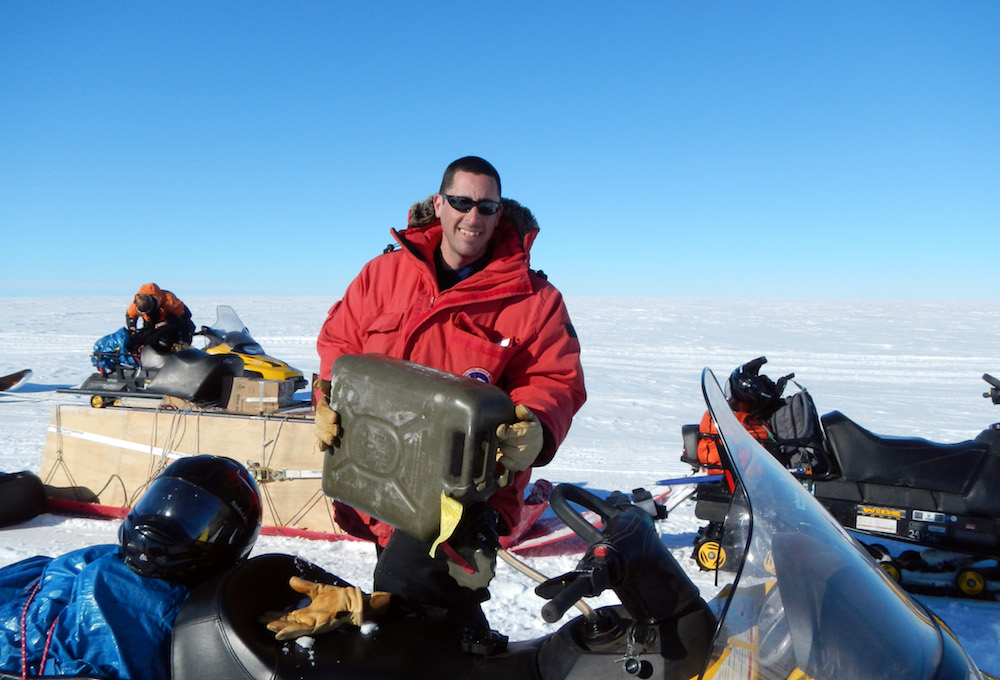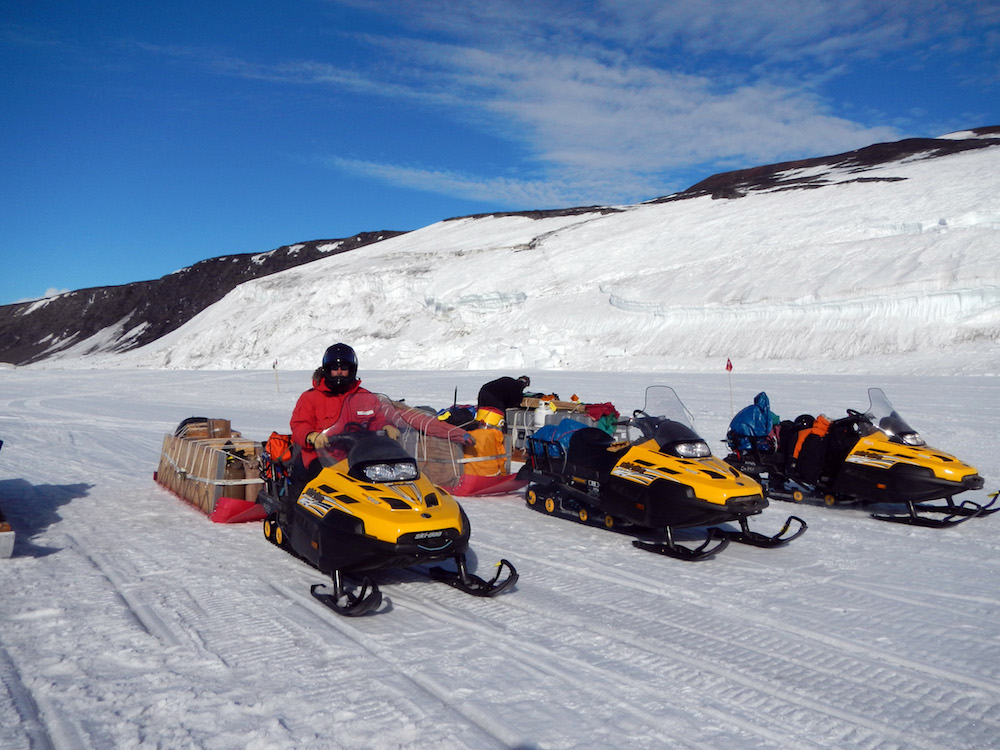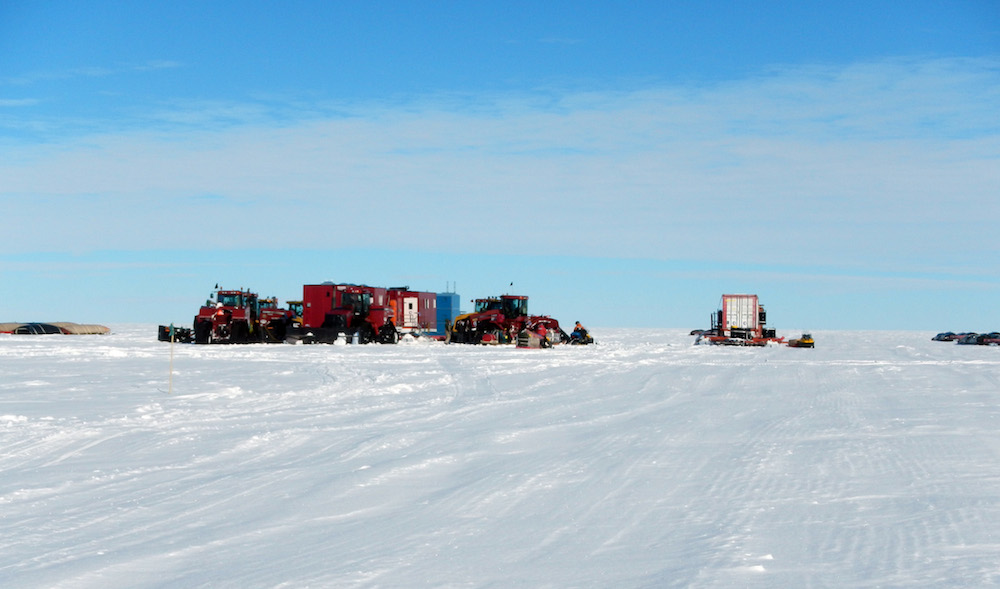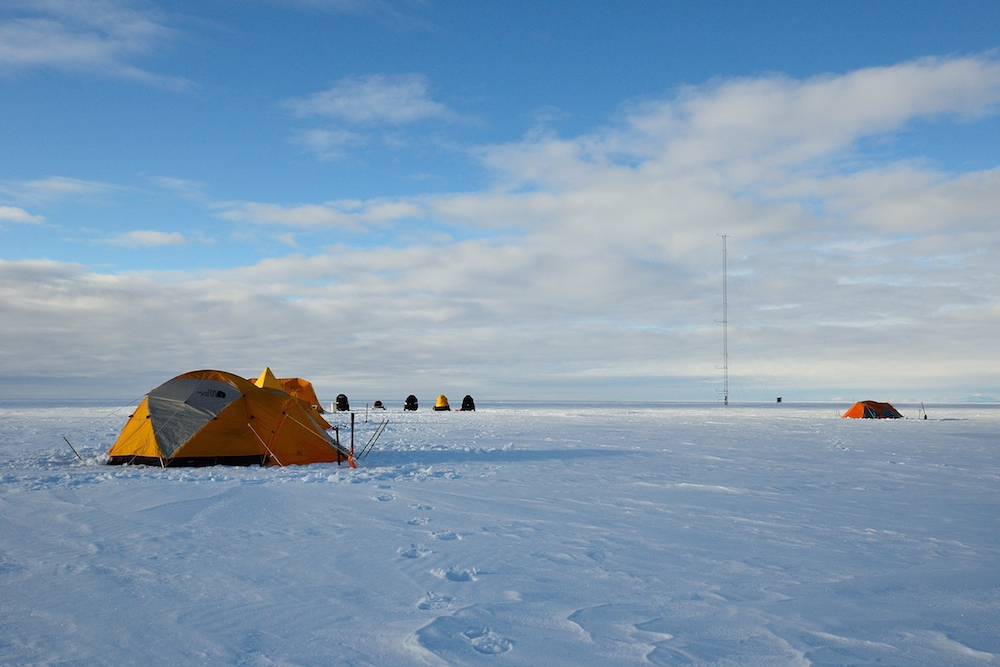15 January 2014
Yesterday was a looooong day. After getting a big breakfast and doing some final packing we left McMurdo at 8AM. It was a short drive from McMurdo to the edge of the Ross Ice Shelf where our snowmobiles and sleds were parked. We finished packing the sleds under sunny skies with light winds and a temperature in the mid-30s F. It was perfect weather for the long snowmobile ride to our Tall Tower field camp.
We started our snowmobile traverse at 9:30, following the snow road that goes to the main USAP runway. Before getting to the runway we turned east and began following the South Pole traverse route. This route runs between Ross Island, with the large volcanic peaks of Mt. Erebus and Terror, to the north and White Island and Minna Bluff to the south.
I was pleased to see that the snowmobiles were able to pull the heavy (over 1200 pounds each) sleds with no problem and we made good progress. The main concern for the day was crossing the crevassed shear zone. We arrived at the shear zone around 11:30. The shear zone was 4 miles wide and each crevasse was marked by a 4×4 piece of wood stuck in the ground. Each of these marked a large crevasse that had been backfilled with snow earlier in the season, as part of preparing the “road” for the South Pole traverse. We passed more than 20 of these large crevasses. Had they not been marked with the 4×4’s we wouldn’t have even known we were passing over a crevasse.

The only gas stations on our route were ones we provided with the spare jerry cans of fuel we carried.
From there we still had about 70 miles of riding to get to our field camp and our route turned almost due south at this point. We now had White Island and Minna Bluff to our west and they provided something to look at other than the flat white surface of the Ross Ice Shelf to our south and east. The snow road was marked by colored flags on bamboo poles every 1/8th of a mile. There were some snow drifts across the road that would cause our sleds to fishtail a bit if we hit them too quickly. We found that 25 miles per hour was about the fastest we could ride without losing control of our heavy loads and we often rode a bit slower than that.
Eventually we passed south of White Island and Minna Bluff. At that point the entire view in front of us was flat and white. From horizon to horizon the biggest topographic features we saw were the snow drifts and sastrugi (large snow drifts) that rose at most 1 to 2 feet above the surface. As I rode through this flat, alien landscape I thought that it looked like we were riding across a white ocean. The snow drifts were the waves on this frozen ocean and just like riding a small boat across the ocean these drifts continually bounced and battered us as we crossed the icy plain.
After several hours of riding through this flat landscape I was surprised to see several dark “dots” on the horizon. As we got closer we realized that these “dots” were the snow tractors and sleds of the South Pole traverse team. They had left the South Pole over two weeks earlier and were just a few days away from getting back to McMurdo. It was exciting to run into other people and we stopped to talk with them for a few minutes.
The traverse delivers 120,000+ gallons of fuel to the South Pole station each summer. The traverse is made up of large snow tractors and sleds which burn a lot of fuel. It takes almost 80,000 gallons of fuel for the traverse to go from McMurdo to the South Pole and back again, so every gallon of fuel burned at the South Pole is really the equivalent of almost 2 gallons of fuel (neglecting the amount of fuel required to get the fuel to Antarctica in the first place). While this ratio of fuel burned to fuel delivered may not seem very good it is much better than the alternative which is to fly all of the fuel to the South Pole on LC-130 flights, which can only deliver 1000 gallons of fuel per flight. This means that the traverse saves over 100 roundtrip flights to the South Pole each summer.
Despite, or maybe because of, the absolutely flat terrain we were crossing I began to notice subtle features in the landscape – things like changes in the spacing and size of the snow drifts or the consistency of the snow surface which varied from icy and hard to areas of softer snow. I also noticed the changing quality of the light. Under clear skies the snow was bright white with just a hint of a bluish cast. As the sky became more overcast the snow took on a silver color that mirrored the grey clouds above. As the sun sank lower in the sky below the clouds the ice shelf took on a golden glow. It’s amazing how much you can see in an environment that appears to be devoid of any features at all.
The next major “landmark” we saw on our crossing of the Ross Ice Shelf was the 100 foot tall Tall Tower automatic weather station (AWS) where we’d be camping. We spotted the tower almost 8 miles before we got to camp. All told, we had covered almost 110 miles by snowmobile in just over 10 hours. It had been a very long day and we were all tired from the constant bouncing and jostling of the ride across the snow drifts, the incessant drone of the snowmobile engines, and from breathing the snowmobile exhaust all day.
After we arrived at our camp we could see storm clouds building on the horizon so we quickly began setting up our tents. Our camp consists of 6 tents – a large 10 x 20 foot tent called an Arctic Oven that serves as a kitchen and work tent, a pyramid shaped Scott tent that serves as our bathroom, and 4 small mountain tents for sleeping. As we began to unpack our sleds we realized that several of our jerry cans of fuel, a funnel, and a spare snowmobile seat had fallen off of the last sled. While Melissa and Suz started to setup the tents Ben and I got back on the snowmobiles to retrace our route and look for the lost gear. Luckily it had fallen off less than 5 miles from our camp so we didn’t have a long snowmobile ride to retrieve it. On our way back to camp the overcast skies made for very flat lighting that made it impossible to see any of the drifts or bumps on the road.
It took us several hours to setup camp and make a quick dinner of prepackaged dehydrated backpacker meals. It was close to 2AM when I finally crawled into my tent to go to sleep after a very looooong day.
Thanks for reading.
John




